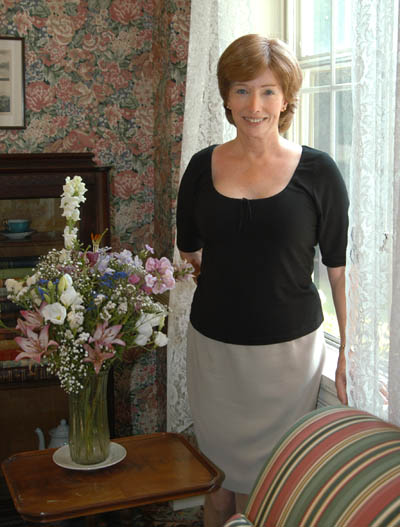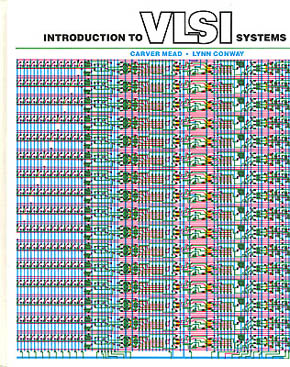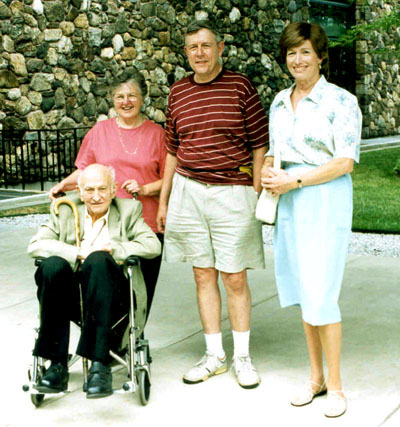
[This webpage was first posted in 2005. It's left here for archival purposes.]
Click here for Lynn's 2016 BioSketch (PDF)
Photo of Lynn Conway, August, 2003
Introducing Lynn Conway,
Prof. of Electrical Engineering & Computer Science, Emerita,
University of Michigan, Ann Arbor
Lynn Conway is a famed pioneer of microelectronics chip design. Her innovations during the 1970's at the Xerox Palo Alto Research Center (PARC) have impacted chip design worldwide. Many high-tech companies and computing methods have foundations in her work.
Lynn received her B.S. and M.S.E.E. degrees from Columbia University in 1962 and 1963. She began her career at IBM Research at Yorktown Heights, NY, in 1964, moving on later to work at Memorex Corporation, at the Xerox Palo Alto Research Center (PARC), and at the Defense Advanced Research Project's Agency (DARPA). Concurrent with her work at Xerox PARC, she served as Visiting Associate Professor of EECS at M.I.T. in 1978-79. She joined the University of Michigan in 1985 as Professor of EECS and Associate Dean of the College of Engineering.
Thousands of chip designers learned their craft from Lynn's book, Introduction to VLSI Systems, which she co-authored with Professor Carver Mead of Caltech. Thousands more did their first VLSI design projects using the government's MOSIS prototyping system, which is based directly on Lynn's work at PARC. Much of the modern silicon chip design revolution is based on her work.
By successfully simplifying and demystifying the previously extremely complex process of silicon chip design, the work of the Mead-Conway team was largely responsible for the rapid progress in VLSI chip design and design tools in the 80's. Taken together, Lynn's many diverse contributions to computer architecture, VLSI design and internet-based chip-prototyping have greatly enhanced later progress in microelectronics, computing and information technology.
Lynn went on to win many awards and high honors, including election as a Member of the National Academy of Engineering, the highest professional recognition an engineer can receive.
What no one knew until recently is that Lynn also did earlier pioneering research at IBM in the 60's. Fresh out of graduate school, she invented a powerful method for issuing multiple out-of-order instructions per machine cycle in supercomputers. By solving this fundamental computer architecture problem back in 1965, she enabled creation of the first true superscalar computer, and participated in its design. Lynn called her invention dynamic instruction scheduling (DIS).
By the 90's, chips held enough transistors so that entire superscalar computers could be put on single chips. Lynn's DIS invention suddenly became used in almost all the powerful new PC chips, making them much more powerful than they would otherwise have been. Lynn's work thus had yet another very major impact on the modern information technology revolution.
Most researchers thought DIS was a generalization of decades of work, having no idea it had been invented in 1965. It caused Lynn great angst to see her wonderful invention so widely used and described in all the computer architecture textbooks, without anyone knowing it was her idea.
How could this oversight have happened? Why did Lynn remain silent for over three decades about her important IBM work?
The reason is that IBM had terminated Lynn's promising young research career in 1968, firing her after learning that she was undergoing transsexual transition from male to female. She had then gone outside the U.S. to complete her transition, come back and started her life all over again.
Starting all over again:
After completing her gender transition in 1968, Lynn took a new name and identity and then restarted her technical career at the bottom of the ladder, as a newly-hired contract programmer at Computer Applications, Inc. Ever so happy and fulfilled in her new life, Lynn’s new career blossomed. She went on to work at Memorex Corporation during 1969-72, and rapidly climbed back up the ladder as a digital system designer and then as a computer architect.
On to success – in “stealth mode”:
While at Memorex, Lynn quickly established a promising new professional identity as a successful woman engineer. She did this while in "stealth mode" – i.e., without people knowing of her past.
During those early pioneering years of gender transition, Lynn had to keep her past a secret just to survive, much less build a career. It was a scary time, because any “outings” could well have ended her new career and seriously threatened her chances for a productive and fulfilling life.
Lynn was successful in this effort, moving on to join the Xerox Palo Alto Research Center (PARC) in 1973 where she did her creative VLSI systems work, and the rest is history.
 |
Introduction to VLSI Systems Published in the fall of 1979
Within a few years, this seminal text was adopted for VLSI chip-design courses at over 100 universities throughout the world.
Along with the associated "MOSIS" rapid-prototyping infrastructure (also based on Lynn's innovations) the text was largely responsible for the huge wave of chip design innovations during the 1980's and 90's, especially out in Silicon Valley.
|
Interactions with Defense Community:
Lynn’s innovations in VLSI design were of strategic significance not only in the commercial sector, but also in the defense industry. As a result, she was recruited in the early 80’s by the Defense Advanced Research Projects Agency (DARPA). At DARPA she became a key technical architect and leader of planning of the DoD’s “Strategic Computing Initiative” (SCI), serving in DoD's Senior Executive Service as Assistant Director for Strategic Computing at DARPA.
In order for Lynn to enter this assignment, her past had to be quietly and secretly vetted by the Defense Investigative Service (DIS). Unlike the frequent firings and employer rejections of individuals known to have transitioned in the civilian sector at the time, Lynn was able to obtain the required approvals and Top Secret clearance, and thus move into her new position at DARPA.
 |
The Strategic Computing Plan
Lynn Conway, Planning Leader & Editor
Released in November 1983 by the Defense Advanced Research Projects Agency
|
SCI was a major program in high-performance computing, machine intelligence, autonomous systems and intelligent weapons technologies created to forestall Soviet aims during the height of the Cold War. Reporting to Dr. Robert Cooper, Director of DARPA and Assistant Secretary of Defense, Lynn led the effort that produced the Strategic Computing Plan in November 1983, and then went on to guide the program during its formative years.
Outgrowths of SCI research include new paradigms in intelligent systems that now
help to underpin modern defense technology, especially in areas such as
battle-management systems, intelligent weapons and autonomous land, sea and air
vehicles.
Moving on to academe:
In 1985, Ms. Conway was recruited by the University of Michigan as Professor of EECS and Associate Dean of Engineering. There she contributed to many research and educational initiatives during the period of rapid expansion of the College of Engineering onto the University's North Campus in the 1980's and 90's. Lynn’s research work at Michigan focused on visual communications and control, and she has received five U.S. Patents for visual communications and control inventions.
Lynn retired from active faculty status in December 1998 as Professor of EECS, Emerita. She lives with her husband Charlie (also an engineer) and their four cats, on a 23 acre homestead in rural Michigan out to the west of Ann Arbor. Charlie and Lynn enjoy sharing many interests and pastimes, and have been together for over 17 years now.
Quietly coming out:
By 1999, computer historians searching for the origins of DIS were becoming aware of Lynn’s early innovative work at IBM. Facing a difficult choice of what to do after 31 long years of living in stealth, Lynn gradually and quietly began "coming out". She began by using her website to inform colleagues, hoping to tell her story in her own words rather than have it just spill out.
Lynn’s story became increasingly widely read over the following years, and her website, http://www.lynnconway.com, has gradually evolved into a heavily-accessed, highly-respected informational site on the topics of transgenderism, transsexualism and gender transition.
Lynn has also consulted with a number of high-tech firms on equal opportunity hiring and employment protections for transgender and transsexual workers, sensing that many of these companies are highly committed to diversity and inclusiveness and thus are receptive to ensuring their policies reflect that commitment.
Many high-tech firms have already adopted such protections, including major firms such as
Apple, HP, Intel, Kodak, Lucent, NCR, Verizon Wireless, Xerox and yes – even IBM!
Lynn hopes that her story, and the stories of many hundreds of others who have successfully transitioned, will help more companies understand the importance of such protections to those involved, and the benefits that accrue to companies that provide them.
Awards and recognition:
Professor Conway has received many major awards for her research contributions, including the Wetherill Medal of the Franklin Institute, the Pender Award of the Moore School at the University of Pennsylvania, the Secretary of Defense Meritorious Achievement Award, the Electronics Award for Achievement, Xerox Corporation's recognition as a Xerox Research Fellow, the National Achievement Award of the Society of Women Engineers (SWE), the GLBT Engineer of the Year Award from the National Organization of Gay and Lesbian Scientists and Technical Professionals (NOGLSTP), an honorary doctorate from Trinity College, election as a Fellow of the IEEE (Lynn was the 12th woman to be so elected), election to the National Academy of Engineering, and election to the Electronic Design Hall of Fame.
Lynn has also served on many significant committees and boards, including the Editorial board of IEEE Spectrum magazine, numerous committees of the National Science Foundation and the National Academy of Engineering, and the U.S Air Force Scientific Advisory Board. She has served on the Board of Visitors of the U.S. Air Force Academy (a Presidential appointment (more)), as a Member of the Corporation of the Draper Lab, as a member of NASA's Office of Space Science Task Force on Technology Readiness, and as a Member of the Council of the Government-University-Industry Research Roundtable (GUIRR) and also of the Air Force Science and Technology Board of the National Academies.
|
|
Members of the Board of Visitors of the get ready for some flying
Left to right: Ambassador Fred Zeder U.S. Rep. Pete Peterson (D-FL) U.S. Rep. John Tanner (D-TN) Prof. Lynn Conway Gen. Brent Scowcroft
July 1996
|
Additional information:
Introducing Lynn Conway (Printable PDF version of the above biographical sketch).
Lynn's invention of Dynamic Instruction Scheduling while at IBM.
Lynn's innovations in VLSI system design methods while at Xerox PARC.
Impact of the Mead-Conway VLSI chip design innovations.
Lynn's invention of Dynamic Instruction Scheduling while at IBM:
Lynn joined IBM Research at Yorktown Heights, NY, in 1964. While at IBM, she made major contributions to supercomputer system architecture, including the invention in 1965 of generalized (multiple-decode, multiple-issue) "dynamic instruction scheduling", which was adopted in the IBM ACS-1 supercomputer's architecture.
Although the ACS-1 project was later cancelled and that machine never saw the light of day, Lynn's invention survived: Dynamic instruction scheduling has since become a classic hardware method for enhancing the performance of VLSI superscalar processors, such as those made by Intel, Sun, HP, MIPS and Compaq.
For information about this important IBM project, see Dr. Mark Smotherman's ACS retrospective at http://www.cs.clemson.edu/~mark/acs.html . The history of this long-secret IBM project is being constructed there with help from ACS veterans, using early ACS technical archives including Lynn's personal ACS archive.
|
|
Figures from the original IBM confidential technical report that described Lynn's innovation of multi-issue out-of-order dynamic instruction scheduling February 23, 1966 |
Lynn's innovations in VLSI system design methods while at Xerox PARC:
Lynn joined Xerox Palo Alto Research Center (PARC) in 1973, where she went on to international recognition as a pioneer of computing and microelectronics for her innovations in VLSI chip design methods. In a collaboration with Prof. Carver Mead of Caltech from 1975-1980, Lynn inspired and led a team of colleagues and students at Xerox PARC and Caltech in research to bridge the knowledge gap between digital system architecture and microelectronics.
This research produced a "structured VLSI design methodology" that was easy to teach and learn from the viewpoint of digital system architects and designers. Lynn then conceptualized and co-authored Introduction to VLSI Systems, which became the seminal textbook on modern chip design. She also created and taught the first modern VLSI design course based on that text, while serving as Visiting Associate Professor of EECS at M.I.T., in 1978-79.
A key element of the new design methodology was Lynn's invention of scalable, ratioed design rules that greatly simplified designer conceptualization and computer processing of VLSI circuit layouts. Prof. Mead introduced Lynn's new "lambda-based" design rules into the design of the OM-2 computer at Caltech, which became the classic system design example used throughout the Mead-Conway textbook.
While at Xerox PARC, Ms. Conway also invented an internet-based infrastructure and protocols for efficient, rapid prototyping of large numbers of VLSI chip designs. Lynn's "MPC service" was prototyped and operated at PARC in 1979 and 1980 to support rapid prototyping of student chip designs at "Mead-Conway" design courses at many universities.
The new rapid chip-prototyping technology Lynn had pioneered was transferred to the Information Sciences Institute (ISI) at USC in 1981, where it became known as the "MOSIS" service. ISI has operated and evolved MOSIS for the past 20 years with support from DARPA and NSF. MOSIS has long been a national infrastructure for rapid prototyping of VLSI chips by many universities and research organizations, and similar services have been created in many other countries around the world.
By successfully simplifying and demystifying the previously extremely complex process of silicon chip design, the work of the Mead-Conway team was largely responsible for the rapid progress in VLSI chip design and design tools in the 80's. Taken together, Lynn's many diverse contributions to computer architecture, VLSI design and internet-based chip-prototyping have greatly enhanced later progress in microelectronics, computing and information technology.
For further information, see:
Impact of the Mead-Conway VLSI chip design innovations,
and of the MOSIS service based on Lynn Conway's MPC prototype.
 |
Lynn Conway |
|
|

|
|

|
|

|
|
Lynn at MIT in Oct 2008, while in Cambridge for the Annual Meeting at Draper Lab
where Lynn is a Member of the Corporation

Copyright @ 2005-2008, Lynn Conway.
All Rights Reserved.